
|
Some 36 models from foreign carmakers and 84 by domestic brands will make their global premieres at the show, which opens today and continues until May 2. Covering 230,000 square meters, the exhibit has a total of 1,125 vehicles on display. |
Special edition for the 12th Beijing International Automotive Exhibition
Best, most and newest models as the competition reaches a fevered pitch
When the first Beijing International Automotive Exhibition was held 22 years ago, 216 motor vehicles were on display, and that number included motorcycles.
Today a record-high 1,125 vehicles from carmakers both at home and broad are showcased at the grand event held every two years in the capital city.
Among the vast range of exhibits, 36 vehicles made by foreign carmakers and 84 cars by domestic manufacturers are making their global premieres.
Organizers say almost every major foreign carmaker is joining the gala that will last until May 2 and attract almost a million visitors.
The total exhibition area is a record as well - an all-time high of 230,000 square meters.
The increasing size and importance of the exhibition is another indication of explosive growth over the past two decades as China rose to become the No 1 auto market in the world.
Last year new car sales in the country totaled 18.5 million units, retaining the country's top position for the third consecutive year.
But growth slowed to 2.5 percent from strong double-digit growth in 2009 and 2010, largely due to the expiry of government incentives on small cars.
In the first quarter this year, the numbers actually fell as 1.25 percent fewer passenger vehicles were sold than in the same period last year, according to statistics from China Association of Automobile Manufacturers (CAAM).
But the good news is that the rest of the year is likely to be better than the first quarter. Industry consultancy IHS forecasts that passenger vehicle sales in China will increase about 8 percent this year and LMC Automotive projects 9 percent growth.
As sales grow at a slower pace, competition is becoming even more fierce. To stand out in the increasingly crowded marketplace, carmakers are bringing their best and latest products to the auto show.
Foreign carmakers
Volkswagen Group, the largest passenger car producer in China, has booked an entire hall of more than 9,600 square meters to showcase models under its eight brands Volkswagen, Audi, Bentley, Bugatti, Lamborgini, SEAT, Skoda and Porsche.
Thirty-one Volkswagen-branded models - including the E-Bugster electric car, Cross Coupe and new Lavida making their global debuts in China - are on display across about a third area of the hall.
In a bid to consolidate its leadership position, the automaker has formulated a record 14 billion euro ($18.2 billion) investment plan from 2012 to 2016 to further expand capacity and its lineup of new models.
Its two joint ventures in China have a total of seven existing vehicle plants, with three more under construction that when completed will bring Volkswagen's production capacity in the country to 3 million units, possibly as early as next year.
Volkswagen is not the only foreign carmakers moving aggressively to raise output in China.
In just two weeks, US carmaker Ford Motor's three-way tie-up with Mazda and China's Chang'an Automobile Group announced two ambitious plans to expand capacity.
On April 5, it announced it would invest $600 million yuan in a new plant in Chongqing. Fourteen days later it released another plan to build a $760 million yuan facility in Hangzhou.
The intensive investment could push the joint venture's total yearly output in China to more than 1.2 million units by 2015.
Last year, Ford promised to bring 15 new models to China before 2015.
At the Beijing Auto Show it will show a rich lineup led by the all-new Focus and its three latest SUVs.
"The Chinese market is so important to foreign automakers that they have to accelerate the introduction of new cars and provide a complete and diverse lineup," said Zhong Shi, an independent auto analyst based in Beijing.
New faces are always intriguing at auto shows.
Absent from the last Beijing Auto Show, Italian carmaker Fiat returns to the stage this year with the global debut of the Viaggio, the first model to be produced at its joint venture with Guangzhou Automobile Group.
The compact car is scheduled to hit the market in the third quarter this year and its market acceptance will count a great deal on whether the Italian manufacturer can make a successful comeback to China. Its previous partnership with Nanjing Automobile Corp failed in 2007.
Domestic brands
For domestic carmakers, the hard days began last year as tax breaks on small cars lapsed and the overall market slowed.
"Domestic brands benefited the most from incentives on small cars and were impacted the most after the favorable policy expired," said Lin Huaibin, an auto analyst at IHS.
In the first three months of this year, the market share of indigenous-brand passenger cars, including minivans, dropped to 42.9 percent, a decline of 3.2 percentage points from a year ago, according to CAAM.
"The good result of a stressed market environment is that carmakers have to place more emphasize on quality, so at this year's Beijing Auto Show, new products by homegrown carmakers and the changes in their strategies are worth seeing," Zhong said.
Anhui-based Chery Automobile Co is showing 20 models at the auto show, including three models making their global premieres.
The Cowin 5, Riich G2 and new Eastar, which augment Chery's classic product portfolio of the Tiggo, QQ, A3 and G3, represent the carmaker's increasing competitive strength.
Two concept vehicles on display by Chery show its improving capacity for innovation.
The concept SUV TX features a streamlined body that draws its inspiration from the surface tension of water. The new energy concept @ant, which gets its name for a bionic exterior, is a nimble, futuristic small car with components that can be connected to increase fuel mileage.
BAIC Group, the partner of Daimler AG and Hyundai, will debut the first mid-sized sedan carrying its wholly owned Beijing marque.
Based on Saab technologies the group acquired in 2009, the car is designed to tap more affluent local customers than the other compact models made by the group.
Passion for SUVs
Spectators to the auto show this year might get an impression that Chinese consumers are obsessed by big, tall SUVs.
Almost every carmaker, both in the luxury and mass-market segments, is displaying the brawny vehicles.
Even super luxury brands Bentley, Maserati and Lamborghini are bringing SUV concept vehicles to Beijing. Mainstream luxury carmakers like Audi, BMW and Mercedes-Benz all have SUV displays and have started local production of SUVs in China.
Nissan announced three days before the auto show that it will produce cars by its luxury brand Infiniti in China at the joint venture with Dongfeng Motor Corp starting from 2014. The company didn't specify the models to be made in China, but market observers believe that there's a good chance the carmaker will build its FX series SUVs here.
In the non-luxury segment, SUVs on show include the Ford Kuga, Mazda CX-5, Buick Encore, Citroen C4 Aircross. Domestic carmakers Geely and Chang'an are debuting their first-ever SUVs.
In all, about 30 new SUV models are expected to join the marketplace this year to cash in on the booming segment.
"In terms of love for the SUV, China is becoming more like the US," said Zeng Zhiling, director of LMC Automotive Asia Pacific Forecasting.
CAAM statistics shows that China's SUV sales last year totaled nearly 1.6 million units, an increase of 20 percent from 2010.
Industry analysts forecast that the passion is likely to continue for the next five years as more families buy a second car. But Zeng warned that as fuel prices rise, sales of the big gas guzzlers might weaken after 2015, similar to the situation in Europe today.
New energy
Just five days before the opening of the auto show, China's State Council adopted an industry development plan on energy-saving and new-energy vehicles.
The plan sets a production and sales target of 500,000 all-electric and plug-in hybrid vehicles by 2015 and more than 5 million by 2020.
The plan also calls for average fuel consumption in passenger cars produced in 2015 to be reduced to 6.9 liters per 100 km and to 5 liters per 100 km in 2010.
Some 88 new-energy vehicles will appear at the Beijing Auto Show, according to organizers.
Toyota, together with its joint ventures and luxury unit Lexus, is showcasing 50 models at the event, about a third of them hybrid or electric vehicles.
Well-known for its successful gasoline-hybrid Prius, especially in the US, the Japanese carmaker is about to localize its latest energy-saving technology in China and has a long-term plan for hybrids to account for 20 percent of its sales in the country.
Honda is bringing its CR-Z and Insight hybrid vehicles to the show, both of which will be imported to China later this year. The company also plans to build an electric Fit at its joint venture with Guangzhou Automobile Group by the end of this year.
And domestic carmakers have no intention of being overshadowed by their foreign competitors in the field.
SAIC Motor is displaying the Roewe 550 plug-in hybrid that will be put into volume production this year. The pure-electric Roewe E50, which making its first public appearance, is also expected to be produced within the year.
BYD, the Shenzhen-based battery and car maker backed by Warren Buffett, has high expectations for its second-generation F3DM dual-mode electric vehicle.
The car named Qin after China's first imperial dynasty can be powered solely with electricity or driven in hybrid mode.
It has a battery pack only half the weight of the previous generation and can accelerate from zero to 100 km in 6.9 seconds while using an average of 16 yuan worth of fuel per100 km, which is about the cost of 2 liters of gasoline in China today.
The carmaker's joint venture with Daimler AG is displaying its first show car under the Denza brand in Beijing. The all-electric vehicle is set to hit the market next year.
Contact the writers at gongzhengzheng@chinadaily.com.cn and hantianyang@chinadaily.com.cn
(China Daily 04/23/2012 page33)
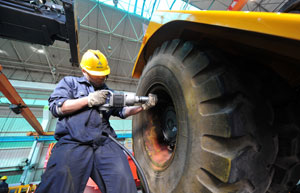 A workshop of Sany Heavy Industry Co in Changsha
A workshop of Sany Heavy Industry Co in Changsha
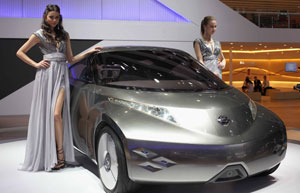 A Dongfeng Nissan car at the Guangzhou Auto Show 2012
A Dongfeng Nissan car at the Guangzhou Auto Show 2012
 Rural grid upgrades to ensure electricity
Rural grid upgrades to ensure electricity
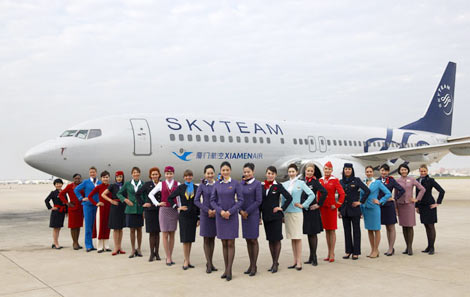 Xiamen Airlines joins SkyTeam
Xiamen Airlines joins SkyTeam
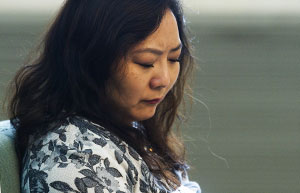 Divorce pushes female tycoon from top spot
Divorce pushes female tycoon from top spot
 New career, new dream
New career, new dream
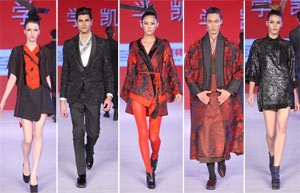 Hengyuanxiang becomes official partner of COC
Hengyuanxiang becomes official partner of COC
 A more global yuan
A more global yuan